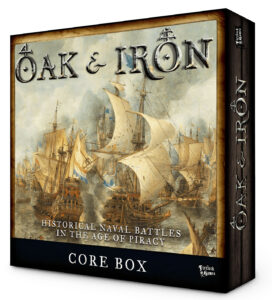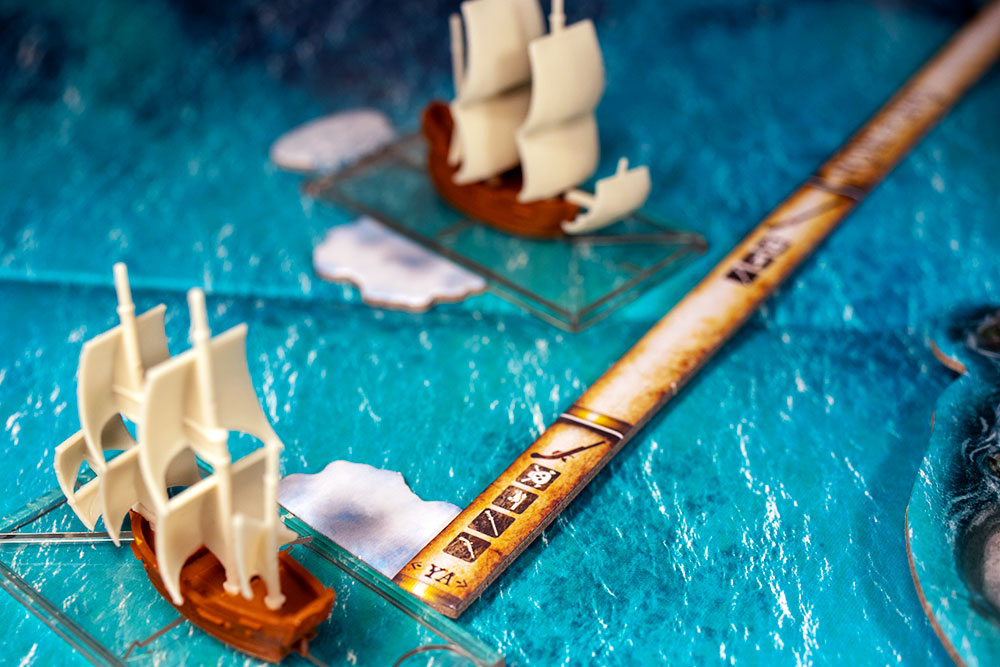 Take a step back to the 1600s and 1700s with me. It was a time when tall-masted wooden sailing ships ruled the seas. An era of pirates, imperial expansion, and broadside shots. The age of sail has always been a fascination for me so I’ve long wanted to try Oak and Iron from Firelock Games. It’s a 1/600th scale naval game set during the Age of Piracy. The core box offers a fully contained experience for 2 players that takes about an hour to play. If you’ve ever considered trying out an age of piracy skirmish game, then read on!
Take a step back to the 1600s and 1700s with me. It was a time when tall-masted wooden sailing ships ruled the seas. An era of pirates, imperial expansion, and broadside shots. The age of sail has always been a fascination for me so I’ve long wanted to try Oak and Iron from Firelock Games. It’s a 1/600th scale naval game set during the Age of Piracy. The core box offers a fully contained experience for 2 players that takes about an hour to play. If you’ve ever considered trying out an age of piracy skirmish game, then read on!
Gameplay Overview:
Like many miniature skirmish games, players start out by building their fleet. In this case, it’s choosing an admiral and a set of sailing ships. Oak and Iron comes with 6 mostly-assembled ships for the players to choose from (the sails must be slotted in). The ships come in different weight classes from small Sloops to Light Galleons. Players will build out their navy using a point value system that should be familiar to anyone who’s played a skirmish game before. This will also be a high-level overview of the gameplay, if you want the full rundown, you can download a pdf of the rules here.
Every game is divided into a series of rounds, each of which has four phases:

1. Initiative Phase – Both players reveal their initiative card and the player with the higher number gets to go first in the next two phases. They also may activate the power on their chosen card, if applicable. Finally, they must secretly choose their initiative card for the next round. This means you’ll need to pick your initiative card before you know the state your fleet will be in.
2. Movement – Players alternate moving their ships using a set of movement tools (if you’ve played X-Wing, this should be somewhat familiar). Each tool has a length matching possible ship speeds and a pointy end to be used for pivoting your ship when you want to turn. Players can also take a crew action here that will let them do things like rally their crew, change their sails, and reload their canons.
3. Attack – Ships can attack via either Broadsides, Partial Fire (muskets and such), or Boarding, with the first two being the most common. Attacking boils down to being within firing range and rolling some dice. The right symbols will score hits or critical hits. Hits will reduce your opponent’s ship’s hull value and give the crew fatigue. Once both are gone this ship is out of action.
4. End Phase – A clean up phase that will have you checking for things like sinking ships or an admiral surrendering.
Rounds continue in this manner until one side has claimed victory.

Game Experience:
One of the nice things about Oak and Iron is that the rulebook gives you all the basic rules and termanolgoy first, and then gets into more granular stuff. In fact, the rulebook even has a learning game for you that omits some of the more complex rules. I will say that I’d recommend playing the learning game once, or maybe just part of it. It’s a good way for you to get your feet wet (pun intended), but once you wrap your head around everything, definitely move on to the full game. Once you start adding in events, raking shots, formations, etc… the game gets a lot more interesting.

But even with the full rules overhead, Oak and Iron isn’t a terribly complex game. You’ll have some skill cards that will modify rolls, or initiative cards that can affect your turns for the round, but at its heart, it’s a “line ship up and roll some dice” game. When people think of historical games from the 1700s, you are probably expecting tons of charts and little chits and counters. Oak and Iron eschews all of that for a more streamlined experience that gets players right into the action. If you love games that get you solidly into the minor details to recreate things as specific as possible, then this one is probably not a good fit for you.
But if you just watched a few episodes of Black Sails and want to embrace your inner pirate for a while, Oak and Iron is an excellent choice. Even after putting the game on the shelf for a bit, it was pretty easy to get back to the table after a break. Even things like wind direction are pretty easy to grasp. That’s also one of the nice things about the game, just how modular it is. Don’t want to spend time adding upgrades to a ship or having to remember how a raking shot works? Just ignore it. You can freely choose the rules for whatever level of depth and complexity you’d like.

History buffs will also appreciate the detail that designer Mike Tunez put into the game. The rulebook even has a few sidebars here and there on why he made different design decisions, which I found fascinating. I’ll admit, I’m far from an expert at this era, but many of the ships and cards seem to take their design roots from their historical counterparts. Each nationality has not only its own specific perks, but also nation-specific initiative cards (to ba added to the pool of general ones). In addition to that, some of the upgrades are keyed to specific factions. So if you want your crew to be Buccaneers, you’ll need to make sure you are playing the appropriate faction. This helps to give the game some nice replay value as you’ll want to try out different combinations for your fleet.
The game also has some pretty solid production values. The ships, while not as nice as Sails of Glory’s painted minis, still look pretty good. Some of the sails can be a bit finicky though and I ended up having to glue a few in to get them to stay. The game also comes with a foldable map of the ocean for added immersion, however, the folds don’t really go away. More than once we had a ship get stuck on them while trying to move. If you were going to play this often, I’d dump that for a neoprene mat.
Final Thoughts:
For those that saw the “historical” theme on this game and were immediately scared away at the thought of tons of tiny counters and an 80-page rulebook overladen with charts, fear not. Oak and Iron is a fantastic entry-level skirmish game. It’s light enough that you can jump in and start playing rather quickly, yet still offers enough customization options where you are not going to get bored right away. Firelock games also seems to be supporting it quite well as a number of expansion packs have already been released. If you have even a passing interest in nautical skirmish games then this one is worth giving a try.
Final Score: 4 Stars – A great entry into the nautical skirmish genre that has enough content to keep you going for a while.
 Hits:
Hits:
• Streamlined rules
• Lots of options for setting up your fleet
• Nice looking ships
• Expansions out already
Misses:
• Folds on the map hinder gameplay
• Some of the sails have to be glued on























Seems similar to Sails of Glory. No?
Yup, it is. It’s definitely more streamlined though. I like it better than Sails of Glory. Feels a bit less fiddly.
pssh… not enough negatives for a 4 out of 5 stars bro. Need to expand the number of stars in your ranking system if it is.
i think you are putting a little too much focus on distilling 1200+ words down to a signal number…
Good review. Appreciate the time in writing the article.
Shameless plug… For those interested in the game after reading the review, there is more content and info related to Oak & Iron on https://TimberAndSail.com